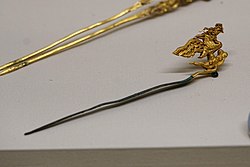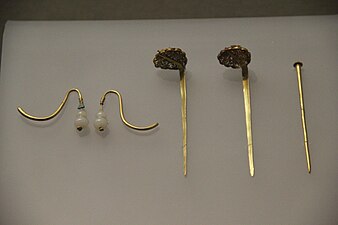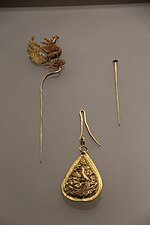Chinese hairpin
 Two styles of Chinese hairpin, zan and chai. | |
| Type | Traditional Chinese hairpin |
|---|---|
| Material | Diverse |
| Place of origin | China, at least since the Neolithic Hemudu culture (5500 BC to 3300 BC) |
Ji (Chinese: 筓; pinyin: jī) (also known as fazan (Chinese: 髮簪; pinyin: fàzān), fanzi (Chinese: 簪子; pinyin: zānzi) or zan (Chinese: 簪; pinyin: zān) for short)[1][2] and chai (Chinese: 钗; pinyin: chāi) are generic terms for hairpin in China.[3] Ji (with the same character of 笄) is also the term used for hairpins of the Qin dynasty.[4] The earliest form of Chinese hair stick was found in the Neolithic Hemudu culture relics; the hair stick was called ji (笄), and were made from bones, horns, stones, and jade.[5]
Hairpins are an important symbol in Chinese culture,[1] and are associated with many Chinese cultural traditions and customs.[6] They were also used as every day hair ornaments in ancient China;[3] all Chinese women would wear a hairpin, regardless of their social rank.[7] The materials, elaborateness of the hairpin's ornaments, and the design used to make the hairpins were markers of the wearer's social status.[1][6] Hairpins could be made out of various materials, such as jade, gold, silver, ivory, bronze, bamboo, carved wood, tortoiseshell and bone, as well as others.[3][8][1][9]
Prior to the establishment of the Qing dynasty, both men and women coiled their hair into a bun using a ji.[3] There were many varieties of hairpin, many having their own names to denote specific styles, such as zan, ji, chai, buyao and tiaoxin.[10][3][11]
Cultural
[edit]Burials
[edit]During the Chinese funeral period, women in mourning were not allowed to wear hairpins.[1]
Ji ceremony
[edit]Ji played an important role in the coming-of age of Han Chinese women.[1][4] Before the age of 15 years old, women did not use hairpins, and always kept their hair in braids.[1] When a woman turned 15, she stopped wearing braids, and a hairpin ceremony called "Ji Li" (笄礼), or "hairpin initiation", would be held to mark the rite of passage.[3][1][6][4] During the ceremony, their hair would be coiled into a bun with a ji hairpin.[1][4] After the ceremony, the woman would be eligible for marriage.[3][6][4]
Hairpins as a love token
[edit]Betrothal and wedding customs
[edit]When engaged to be married, Chinese women would take the hairpin from their hair and give it to their male fiancé.[1] After the wedding, the husband would then return the hairpin to his newly-wed wife by placing it back in her hair.[1]
Separation and reunion love token
[edit]The chai hairpin[12] also used to be a form of love token; when lovers were forced to break apart, they would often break a hairpin in half, and each would keep half of the hairpin until they were reunited.[3]
Similarly, when married couples were separated for a long period of time, they would break a hairpin in two and each keep one part.[1] If they were to meet again in the future, they would then put the hairpin together again, as a proof of their identity and as a symbol of their reunion.[1]
Design and construction
[edit]Materials
[edit]
Initially, Chinese people liked hairpins which were made out of bone and jade.[13] Hairpins which were made out of carved jade appeared in China as early as the Neolithic Period (c. 3000–1500 BC), along with jade carving technology.[7] Some ancient Chinese hairpins dating from the Shang dynasty can still be found in some museums.[14]
By the Bronze Age, hairpins which were made out of gold had been introduced into China by people living on the country's Northern borders.[13] Some ancient Chinese hairpins dating back to 300 BC were made from bone, horn, wood, and metal.[8]
The art of engraving wood first appeared in the Tang dynasty, and this new form of art was then applied to large wooden Chinese hairpins.[15] Many of these wooden hairpins were then coated with silver.[15]
In the Ming dynasty, the hairpins became more elaborate, and the carvings were made on silver, ivory, and jade, with pearl being used often as a setting.[15]
Decorations
[edit]Hairpins could also be decorated with gemstones, as well as designs of flowers, dragons, and phoenixes.[8]
Types
[edit]There are various types of Chinese hairpins:
Zan
[edit]The Zan is a type of hairpin with a single pin.[10][9] The Zan could also come in different styles such as:[10]
- Ji-style: A style of zan hairpin which likely refers to the hairpin used to secure the hair in a bun.[10]
- Ruyi-style: A style of zan hairpin in the shape of a ruyi scepter.[10]
- Tiger-head style[10]
- Round-dragon style[10]
-
Shang dynasty bone hairpin
-
Shang Bone Ji
-
Shang bronze hairpin
-
Shang dynasty jade hairpin
-
Spring & Autumn Bronze Hairpin
-
Warring States period bronze hairpin
-
Tang dynasty jade hairpin.
-
Coral hairpin, Song dynasty.
-
Hairpin from Southern Song.
-
Ming jade hairpin decorated with flowers.
-
Ming gold hairpins
-
Tomb of Prince Chuang of Liang-gold hairpins
-
Ming dynasty Jade Hairpins & Ornaments
-
Ming dynasty Hairpins & Gold Earrings
-
Ming Gold Hairpins
-
Ming Gold Earrings and Hairpin
-
Ming Gold Hairpin and gourd earrings
-
Hairpin from China, Qing dynasty, nephrite,
-
Qing dynasty hairpin, Silver gilt
Phoenix hairpin
[edit]Phoenix (Fenghuang) hairpin originated in Qin dynasty and had an upper part made of gold and silver while the feet was made of tortoise shell; it later evolved into the fengguan during the Song dynasty. The fengguan then continued to evolve further in the Ming and Qing dynasties, and in the modern republic.[16] In the Han dynasty, an imperial edict decreed that the hairpin with fenghuang decorations had to become the formal headpiece for the empress dowager and the imperial grandmother.[16] The Fenghuang is an auspicious bird in Chinese tradition and is believed to represent the empress or the bride in a wedding.[17] Phoenix hairpins were also made and used by Peranakan women after settling in the Straits as part of their wedding headdresses.[17]
- Phoenix (Fenghuang) hairpin
-
A pair of fire-gilded silver phoenix hairpins of the Southern Song dynasty.
-
Ming-Qing Gold Earrings & phoenix Hairpin
-
Golden phoenix hairpins from the tomb of Prince Chuang of Liang, Ming dynasty, 15th century
Chai
[edit]The chai is a type of hairpin with double or multiple pins.[10][9] The double-pin chai evolved from the zan; it was frequently found in Chinese poetry and literature as it played an important symbol and as a love token.[12]
-
Jin dynasty (Western & Eastern) Silver Hairpin
-
Tang dynasty chai.
-
Ming dynasty gold hairpin
-
Yuan dynasty chai.
-
peony gold hairpin
-
Tang dynasty,silver,gilt - Royal Ontario Museum
-
Tang Gilded Silver Hairpins
-
Ming Gold Hairpin
-
Silver hairpin of Tang Dynasty
-
Liao dynasty Gold Hairpin
-
Tang Gilded Silver Hairpin
-
Ming dynasty gold chai
Buyao
[edit]The buyao was an elaborate and exquisite form of hairpin which denoted noble status.[3] It was generally made of gold and was often decorated with jewels (such as pearls and jade) and carved designs (such as in the shape of dragons or phoenix).[3][13] It looked similar to a zan,[12] but one of its main characteristics is its dangling features, which gave it its name 'buyao' (lit. "shake as you go" or "that sway with each step" or "step shake").[3][9][18][12] The buyao became popular in the Western Han dynasty.[13]
-
Qing dynasty gold phoenix zan hairpin.
-
Buyao, 18th century
Diancui hairpin
[edit]The diancui hairpin, also known as "kingfisher feather hairpin",[19] were made using the traditional Chinese art of diancui.[18]
-
Kingfisher feather hairpin.
-
Kingfisher feather hairpin
-
Tian-tsui cricket-shaped hairpin
Flower-hairpin headdresses
[edit]The Flower-hairpin headdresses is a generic term which was used to refer to the jewelry and headdresses worn by the Song dynasty Empresses and imperial concubines.[20] The Flower-hairpin headdresses were decorated with flower hairpins.[20] Different numbers of flowers were used depending on the imperial consorts' ranks and specific imperial rules were issued on their usage.[20]
Jin chan yu yue
[edit]Jin Chan yu yue (Chinese: 金蟬玉葉); pinyin: Jīn chán yù yè) Known as the "gold cicada on a jade leaf" hairpin, or "jin zhi yu ye" "Jin zhi yu yue" (Chinese: 金枝玉葉); pinyin: Jīnzhīyùyè) (lit. golden branches and jade leaves) a homonym for the Chinese idiom "one of noble birth",[21] a type of Ming dynasty hairpin in the shape of a cicada made of gold sitting on a piece of jade carved in the shape of a leaf.[9][21]
Tiaoxin
[edit]The Tiaoxin (Chinese: 挑心); pinyin: Tiāo xīn) is a Chinese hairpin worn by women in the Ming dynasty in their hair bun; the upper part of the hairpin was usually in the shape of a Buddhist statue, an immortal, a Sanskrit word, or a phoenix.[11] The Chinese character shou (寿, "longevity") could also be used to decorate the hairpin.[11][22]
See also
[edit]- Hairpin
- Hair stick
- List of Hanfu headwear
- Kanzashi - the Japanese equivalent
- Binyeo - the Korean equivalent
- Fengguan - phoenix crown
References
[edit]- ^ a b c d e f g h i j k l m "Hairpins in Society and Art". Hairpin Museum 百鍊鋼化作繞髮柔 髮簪博物館. Retrieved 2021-05-05.
- ^ Wu, Shu-Ling (2019). Mastering advanced modern Chinese through the classics. Haiwang Yuan. Abingdon, Oxon: Taylor & Francis. pp. 125, 233. ISBN 978-1-315-20897-8. OCLC 1053623258.
- ^ a b c d e f g h i j k "Historical hair ornaments and their social connotations". usa.chinadaily.com.cn. Retrieved 2021-05-05.
- ^ a b c d e Hidden dimensions of education : rhetoric, rituals and anthropology. Werler, Tobias. Wulf, Christoph. Waxmann. 2006. pp. 165–168. ISBN 3-8309-1739-2. OCLC 470776855.
{{cite book}}: CS1 maint: others (link) - ^ "周原遗址出土的骨笄".
- ^ a b c d "Chinese cloisonne hairpin". collection.maas.museum. Retrieved 2021-05-06.
- ^ a b "Material & Technology". Hairpin Museum 百鍊鋼化作繞髮柔 髮簪博物館. Retrieved 2021-05-06.
- ^ a b c Sherrow, Victoria (2006). Encyclopedia of hair : a cultural history. Westport, Conn.: Greenwood Press. p. 179. ISBN 0-313-33145-6. OCLC 61169697.
- ^ a b c d e Yuan, Xiaowei (2017). "Traditional Chinese Jewelry Art: Loss, Rediscovery and Reconstruction Take Headwear as an Example". Proceedings of the 2nd International Conference on Contemporary Education, Social Sciences and Humanities (ICCESSH 2017). Atlantis Press. pp. 550–554. doi:10.2991/iccessh-17.2017.135. ISBN 978-94-6252-351-7.
- ^ a b c d e f g h Living the good life : consumption in the Qing and Ottoman empires of the eighteenth century. Elif Akçetin, Suraiya Faroqhi. Leiden: Brill. 2018. p. 205. ISBN 978-90-04-35345-9. OCLC 1008768840.
{{cite book}}: CS1 maint: others (link) - ^ a b c "Golden Hairpin Decorated with Character "Shou" - Chengdu Museum". www.cdmuseum.com. Retrieved 2021-05-06.
- ^ a b c d "Tradition of China - Hair Ornament Culture | ChinaFetching". ChinaFetching.com. Retrieved 2021-05-06.
- ^ a b c d "Hair Accessories - MIHO MUSEUM". www.miho.jp. Retrieved 2021-05-06.
- ^ "Hairpin 13th–11th century B.C. China". www.metmuseum.org. Archived from the original on 2021-05-06. Retrieved 2021-05-06.
- ^ a b c Lester, Katherine Morris (2004). Accessories of dress : an illustrated encyclopedia. Bess Viola Oerke, Helen Westermann. Mineola, New York. p. 118. ISBN 978-0-486-14049-0. OCLC 857715305.
{{cite book}}: CS1 maint: location missing publisher (link) - ^ a b Cheng, Hui-Mei (2001). "Research on the Form and Symbolism of the Chinese Wedding Phoenix Crown". Proceedings of the Korea Society of Costume Conference: 59–61.
- ^ a b "Phoenix hairpin". www.roots.gov.sg. Retrieved 2022-10-22.
- ^ a b Wu, Yiqian (2020). A Study of Historical Transformation and Cultural Change in Chinese Dian-cui Jewellery [Thesis]. University of Sydney (Thesis). pp. 21, 30, 33, 43–44. hdl:2123/24005.
- ^ "Kingfisher feather hairpin from China". collection.maas.museum. Retrieved 2021-05-06.
- ^ a b c Zhu, Ruixi; 朱瑞熙 (2016). A social history of middle-period China : the Song, Liao, Western Xia and Jin dynasties. Bangwei Zhang, Fusheng Liu, Chongbang Cai, Zengyu Wang, Peter Ditmanson, Bang Qian Zhu (Updated ed.). Cambridge, United Kingdom. pp. 26–27. ISBN 978-1-107-16786-5. OCLC 953576345.
{{cite book}}: CS1 maint: location missing publisher (link) - ^ a b Liu, Fang (2011). "Rare collections of the Ming and Qing Dynasties". europe.chinadaily.com.cn. Archived from the original on 2021-05-06. Retrieved 2021-05-06.
- ^ "Traditional Chinese Hair Jewelry - Ming Style Diji & Tiaopai". www.newhanfu.com. 2020-12-04. Retrieved 2024-05-28.





































